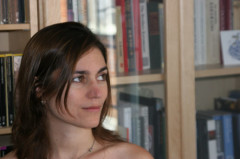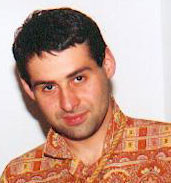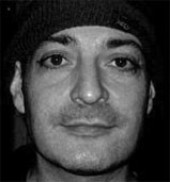Emily Artinian
Emily Artinian was born to an Armenian father in Pennsylvania in 1970. She now lives in London. Her involvement with artist’s books and text-based art is a recurrent theme of her work and can also be regarded as a reminiscence of the Armenian book culture and tradition. Emily Artinian’s conceptual text works add visual expression to abstract language which in turn is often reduced to abstract language again. Her projects resemble translation processes, cryptic, arcane messages which need to be deciphered to grasp their true meaning. Identity is thus tantamount to cryptography and difficult to decode.
Silvina Der-Meguerditchian
Silvina Der-Meguerditchian is the granddaughter of Armenian immigrants to Argentina and was born in Buenos Aires in 1967. She grew up in Argentina and now lives in Berlin. A recurrent theme of her work is the remembrance of the ethnic dislocation of the Armenian people and the genocide they suffered. She uses photographic memorabilia and official documents and merges them in her crochet collages into individual painful stories. Silvina Der-Meguerditchian ties a net. She connects the disparate, builds bridges between worlds apart or seeks a dialogue with the unknown. Her work “Connexion Obsession” is emblematic for this artistic fervour. Her main focus is always on the actual process of joining and dissolving, constructing and deconstructing identity. Silvina Der-Meguerditchian’s work represents a type of mnemonics, namely the individual and collective art of commemoration.
Achot Achot
Achot Achot was born in Yerevan in 1961 and grew up in Armenia. He now lives in Paris. In his spiritual afactum works photography is not only juxtaposed against and mixed with abstract painting: Achot Achot also reconciles two seemingly diverging views of life with each other and synthesises them. His photographs of young women with their palpable eroticism address as well as dissolve the separation of body and soul that is so inherent in Christian-Occidental history. Yet, in his meditative paintings evoking Far Eastern philosophies such dualism no longer appears to exist. The borderline between ‘The Self and the Known’ becomes irrelevant, the yearning for ‘The Infinite’ being the underlying goal .
Archi Galentz
Archi Galentz was born in Moscow in 1971. He comes from an Armenian family with a long history of painters and now lives and works in Berlin. A recurrent theme that is central to his artistic work is the question of Armenian identity, especially in relation to political factors such as the demise of the Soviet Union and the resurgence of Armenian awareness. The search for a paradise lost as the central theme of Archi Galentz’s work was already evident in “The Black Garden” of 1997 in which the aspect and use of colour were, however, key issues – painting as a medium to illustrate the condensation of life and the strategies for survival.
Christopher Atamian
Christopher Atamian is a New York-based writer, translator, critic and filmmaker. He is the author of a novel "Speaking French" and has written for major publications ranging from the New York Press (where he was dance critic) to the New York Times and Inknagir. He also translated Nigoghos Sarafian's "The Vincennes Woods," a classic of Western Armenian Literature and is finishing the translation of Krikor Beledian's seminal "50 Years of Armenian Literature in France." Atamian's short films have screened in international festivals in the United States, Europe and Armenia. He currently writes a column "Studio Visits" for the Armenian Reporter International and is working on the first critical volume about Armenian film in English. He is a graduate of Harvard University and Columbia Business School.







